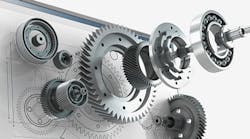Three New Breakthroughs to Advance Metal Additive Manufacturing
Metal additive manufacturing (AM) often draws natural comparisons to more widespread manufacturing methods like injection molding or CNC machining. It’s easy to see why the discussion is often framed this way. Frequently, 3D printing and other techniques are different means to the same end. Such comparisons, however, can tend to oversimplify the real landscape as it exists today.
The challenge with making business or design case comparisons between AM and more established processes is the speed with which AM is evolving. It’s no longer accurate to characterize 3D printing as a single method. Particularly in the metals space, a long list of unique processes have emerged that all fit under the additive umbrella.
As the world of 3D printing continues to broaden, it’s important for hobbyists and businesses alike to remain up-to-speed with the innovations entering the market. These developments are constantly moving boundaries in terms of both design and economic efficiency. Underutilizing new options can limit any manufacturer’s potential. Here’s a look at three promising new metal AM technologies that are delivering real improvements in the here and now.
Metal FDM 3D printing
Two companies have launched metal FDM systems: Markforged and Desktop Metal. Markforged’s Metal X is billed as an “end-to-end solution” for complex metal parts.
This innovative extrusion technique is able to lower the cost of the printer to about $100,000, making it available for wider adoption of metal AM in the workplace. In this the three-part process, the printer extrudes metal rods, a technique more suitable for an office environment than laser sintering metal powders which could theoretically make a (potentially unsafe) mess.
The debinder is a separate piece of equipment that is nonetheless compact and low-maintenance. Using a proprietary debinding agent, parts can be cleared of primary binders in short order. This phase also creates an open pore channel structure which facilitates better sintering in the final step. Small enough to squeeze through a standard walk-door, the FDM systems can also be automated.
The FDM approach boasts some big safety benefits. The key to safety is in the plastic binding around the metal powders. This helps mitigate some of the risks associated with other metal 3D printing methods. It also makes possible certain new capabilities, such as using closed-cell infill to bring down weight and cost.
This new process is great for prototyping, but will never become a production technology cost-competitive with traditional manufacturing.
HP’s Binder Jetting System
Binder jetting is a powder bed process that utilizes inkjet technology and a binding agent. Launching at this year’s International Manufacturing Technology Show (IMTS), HP Metal Jet is the latest binder jetting technology to hit the market. The technology utilizes MIM powder bed and the HP Binding Agent – a water-based liquid agent. Currently, the HP Metal Jet technology is being integrated into a variety of industries. Volkswagen announced their plan to use Metal HP Jet to produce high performance functional parts such as gearshift knobs.
The process starts with a layer of powdered metal that is spread across the entire tray. HP printheads jet the binding agent onto the powder bed in the shape of the part. The liquid agent evaporates, and another layer of powder bed is laid, and this process repeats. Once desired shape is achieved, the powder bed is cured to evaporate and cure the liquid agent. Parts are removed and de-caked, removing remaining powder. The parts are then sintered to achieve final density and can be machined or processed.
Currently, HP Metal Jet offers stainless steel (17-4pH and 316L) to suit a variety of industry needs, but they have announced that they are focused predominantly on the automotive industry.
Intelligent Layering for Economical Metal 3D Printing
A related but proprietary and unique process developed by 3DEO, dubbed Intelligent Layering, takes on six distinct steps to deliver high quality parts at a cost that’s competitive with CNC machining and metal injection molding (MIM) at production volumes. The process produces a superior surface finish and tolerances as compared to any other metal AM process.
The patented technology first spreads a layer of powder across the build area. Next, a binder is applied to give the powder enough rigidity for what comes next. A cutter then organizes the exterior of the part into the final shape that layer should take. This process is repeated layer-by-layer until a finished structure is ready for sintering.
The furnace heats components evenly to ensure a high-quality product that meets expected tolerances. 3DEO also offers a wide variety of post-processing treatments to meet the needs of any application. The part properties are guaranteed to meet or surpass MPIF Standard 35, the manufacturing standard widely used for injection-molded metal parts.
As a service bureau, 3DEO is able to rigorously control for product quality, keep all the overhead expense in-house, and work with significantly lower input costs than would be available to the typical manufacturer. This lower cost structure is ultimately how the company is able to compete on cost and quality with traditional manufacturing techniques like machining and MIM.












